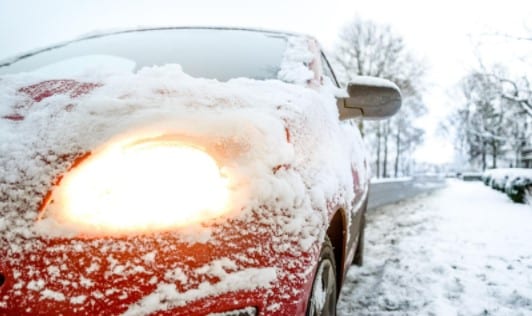
Whether you are a new or experienced driver, driving in the snow can be a daunting task. Snow can make roads slippery and reduce visibility, which can make driving hazardous.
Of course, the more experience you get driving in winter conditions, the more confident you might be when it’s stormy outside. That said, new drivers especially are often hesitant about driving in the winter.
With the right techniques, driving in the winter doesn’t have to be scary or dangerous. We’ve put together some tips and tricks for how to drive in the snow to help you safely navigate the roads in winter weather.
Why is driving in the winter a challenge?
Driving in the winter can be a challenge because of the changeable weather conditions, especially if you’re new to driving in the snow. Ice, snow, and sleet can make roads slippery, reducing visibility and traction. Snow and ice can accumulate on the roadways, making them difficult to navigate and can also cause accidents. Additionally, the reduced daylight hours can be a challenge for drivers on the road in the evening.
Aside from difficulties on the road itself due to weather, the cold temperatures can cause the car’s battery to drain more quickly, making it more difficult to start the vehicle after it’s idle for a while.
How to drive in snow: 6 tips to use this winter
As the weather gets colder, many of us will be taking to the roads in potentially hazardous snowy and icy conditions. Driving in cold weather can be a tricky endeavor, so it’s important to be prepared before you head out. Here are some tips to keep you safe while driving in the snow.
1. Make sure your car is well-maintained
While this is important to do at all times, during the winter you want to be extra cautious in ensuring your vehicle is in good working order. Check your tire health; tread depth, tire pressure, brakes, and wipers. Make sure your headlights and taillights are working properly, and that your antifreeze is full and up-to-date.
2. Switch to snow tires
Whether or not your state has laws pertaining to mandatory snow tires, it’s a good idea to switch out your regular tires to ones better suited for winter roads. Snow tires provide better traction on snow and ice compared to all-season tires, resulting in improved braking, handling, and cornering. They also stay flexible in colder temperatures, which helps maintain traction. With snow tires, you can reduce your risk of getting into an accident due to slippery conditions.
3. Plan with extra time for your journey
When the roads are snowy or icy, it’s always a good idea to leave earlier to allow for extra time to get to your destinations. In harsh winter conditions, all vehicles will be driving slowly, and if the conditions cause an accident on the road, there can be traffic to slow you down even more.
4. Effectively plan routes
Before heading out, check the road conditions and plan accordingly. Always check for weather and traffic updates to see if a particular road on your route is hazardous. In general, when roads are icy or snow-covered, you may want to postpone non-essential trips until conditions improve. If you must head out, plan your route accordingly, allow for extra time, and be patient and alert behind the wheel.
5. Be gentle with the brakes
Driving in the snow requires extra caution and slower speeds. Accelerate and brake slowly, and allow extra distance between you and the car in front of you. It’s also important to avoid sudden turns and stops. If you need to turn, do so slowly and gently. When braking, gradually press on the brakes as sudden stops can cause your vehicle to skid. If the roads are slippery and your car isn’t equipped with anti-lock brakes, you can pump your brakes by repeatedly and gently pressing and releasing them to keep control of the car.
6. Keep supplies in your car
When driving in the snow, it’s important to be prepared for the unexpected. Be sure to carry a basic emergency kit in your vehicle. It should include items such as a flashlight, first aid kit, warm blanket, jumper cables, and a shovel. You might also want to include supplies to get you out of the snow in case your tires get stuck, so leaving some extra car mats, chains, cat litter, or sand in your trunk is always a good idea.
The best gear to drive in the snow
Whenever necessary, it’s ideal to drive in low gear in snow and icy conditions because it allows the driver to have better control over their vehicle. Low gear reduces the amount of power being sent to the wheels, which decreases wheel spin. This helps the driver maintain better traction, which is essential for navigating slippery surfaces. Low gears also allow for a slower and more controlled acceleration, further aiding with traction.
The first step in using low gear is to identify when it’s necessary. Low gear should be used when you’re on a slippery surface, such as ice or snow-covered roads. When driving in the snow, it’s important to remember that low gear is used to slow down the vehicle, not speed it up. To engage the low gear, move the shifter into the appropriate gear, usually marked as “L” or “1” on an automatic transmission.
When driving in low gear, it is important to remember to accelerate and decelerate slowly. Rapid acceleration and deceleration can cause the vehicle to lose control. You should also use the brakes sparingly, as sudden hard braking can cause the vehicle to skid or spin out.
Learn how to drive in snow with Driven2Drive
At Driven2Drive, we’re committed to educating new drivers on driving in all types of road conditions, from sunny summer days to driving in fresh snow. When practicing for your road test with our certified instructors, it’s possible that some of your practice days will be in the winter and in snowy or icy conditions.
Of course, if the weather is very harsh, our PA driving instructors will make a decision based on the conditions and your driving experience as to whether or not it’s a good idea for you to practice that day. However, practicing your driving skills in the ice and snow when accompanied by an instructor is a safe way to gain experience driving in the winter. You can’t predict the weather on the day of your road test, so getting practice in different conditions is a good way to feel more confident when doing your exam.
Get ready to conquer the road this winter
Driving in the winter can be a challenging and nerve-wracking endeavor. With the right preparation and safety measures, however, winter driving can be made much more manageable. Drivers should always check their vehicles before heading out and be prepared for any weather conditions. Taking it slow on the roads, avoiding distractions, and always keeping an eye out for other drivers are all important steps for staying safe on the roads this winter. By following the tips we covered here and by taking the necessary precautions, you can make sure you stay safe on the road this winter.
FAQs
What is the safest speed to drive in the snow?
The safest speed to drive in snow is dependent on the road conditions, vehicle type, and the driver’s experience. Generally, it’s recommended to reduce your speed by half.
What is the safest stopping distance in the snow?
When the road is icy, snowy, and wet, you should double your stopping distance between cars. So, if you usually follow a 3-second stopping distance, double it to 6 or more seconds.
What to do when your car slides in the snow?
The first thing you need to do is remove your foot from the accelerator. Gently press the brakes and turn your wheel slowly in the direction of the slide to help you regain control.

Ronit Tehrani is the Founder and Co-Owner of Driven2Drive, a premier driving and license testing center in Philadelphia. Since 2013, she has been dedicated to providing safe driving education and skills for lifelong success. Under her leadership, Driven2Drive became Pennsylvania’s first privately owned PennDOT-certified testing center, now with six locations.
